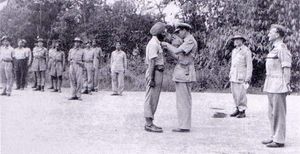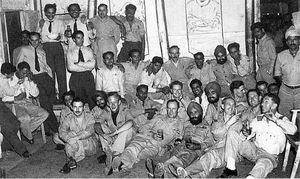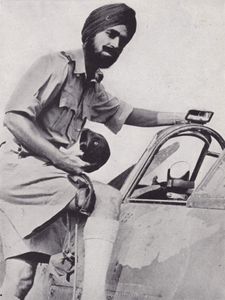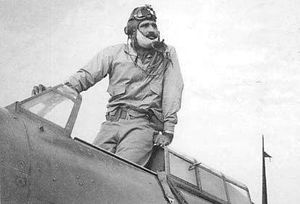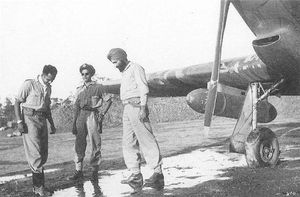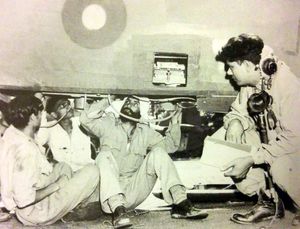June
June saw the squadron starting to re-equip with the Hurricane MkIIc fighter. The IIc variant featured four 20mm Oerlikon cannons in the wings that gave the Hurricane a much stronger punch compared to the puny .303 calibre bullets of the IIb. The conversion had to be carried out without any interruption in the regular pace of operations. The Ground crew had to transition from maintaining and handling .303 inch calibre ammunition and machine guns for the IIB to the 20mm cannon shells for the Oerlikons for the IIC.
In addition to the conversion, The monsoon created many difficulties for the pilot. The runways were often waterlogged, storms made flying hazardous, clouds and rains hampered visibility and returning pilots often found it difficult to locate their strips.
Reconnaissance work was however to continue in spite of these handicaps and so there was no rest for No. 1 Squadron. When No. 28 R.A.F. Squadron-the only other fighter reconnaissance squadron-pulled out in the course of June, No. 1 squadron had to assume the sole responsibility for reconnaissance work in this area.
The squadron flew 327 sorties of which 232 were tactical, 70 photographic, 1 special task, 14 artillery, 8 contact and 2 weather reconnaissances.
During the early part of June the squadron’s effort was mainly over the Imphal-Kohima road where a battle was raging for clearing the road and establishing communication between Kohima and Imphal. The 5th Indian Division fought its way up the Kohima road from Imphal while the 2nd Division marched down the road from Kohima. Obstacles in their way were many but they were surmounted and the two divisions effected a junction on the morning of 22 June.
The usual type of work including observation of Japanese movements, progress of own troops and occasional strafing was carried out by the squadron. The Ukhrul area also received much attention, while the Palel and Tiddim fronts were less frequently visited. No. 1 Squadron had also to assess the damage inflicted by the bombers which was necessary for future tactical target planning.
With the link up on the Imphal Kohima road, the siege of Imphal was finally broken and the Japanese 15th and 31st Divisions began to disintegrate. While still offering resistance they were definitely on the retreat. But in the Palel area and the area south of Imphal,Japanese 33rd Division hung on grimly to its positions and was the last to admit failure.
July
On 2 July the Japanese discontinued the Imphal operations and devoted their attention to forming a defensive line to check the advance of the Allied forces. But the Japanese still had some last minute cards up their sleeves. On the night of 3rd July, a Japanese ground force struck Palel airfield. Palel was on a box defensive position. 2 Harvards, 2 Hurricanes and 3 RAF Spitfires were destroyed by the force. The setback was small and it did nothing to diminish the rest of the RAF’s effort. The part played by the RAF in the successful defence of Imphal cannot be overstatedThe RAF delivered 14,000,000 pounds of rations, 1,000,000 gallons of petrol, 43,000,000 cigarettes and 1,200 bags of mail. On the return journey to their bases, RAF aircraft took out 13,000 wounded and 43,000 non-combatants. They also flew in 12,000 reinforcements while the siege was in progress..
In the first week of July, the squadron had a visit from a very important visitor. The Supreme Commander of Allied Forces in India and Burma, Louis Mountbatten visited the squadron along with Air Marshal Baldwin. He personally pinned the DFC on Arjan Singh’s lapel. It was a proud moment for the Squadron to witness its CO being decorated on the very battlefield that he earned the award.
|
Lord Mountbatten pinned the DFC award on Squadron Leader Arjan Singh. Air Marshal Baldwin can also be seen in the photograph standing to the right. This visit happened in early July 1944
|
|
The Tigers celebrate their CO’s DFC. Air Cmde SF Vincent, AOC 221 Group is lying on the ground along with Sqn Ldr Arjan Singh. L to R Standing (Back Row) Amber (with Bowl), Hafeez (with bottle) , AC Prabhakaran (Standing extreme right). |
On July 18th, the Japanese High Command agreed that a withdrawal was required to the River Chindwin on the Burma side of the Burma/Indian border. The Japanese had sustained 53,000 casualties while the British had lost 17,000 men killed and wounded. By the end of the battle, the RAF had lost 119 aircraft between March and June. They had claimed 33 Japanese fighters and bombers destroyed as confirmed and another 22 as probables . And in the middle of it all, one lone Indian Squadron, led by a legendary officer made sure that the Indian Air Force held its head high and earned the right to count themselves among the defenders of Imphal. They were one squadron that remained in the Imphal valley through the thick of it all.
PostScript:
No.1 Squadron, Indian Air Force would continue its tour on the Burma operations for another nine months. Taking part in the Allied drive against the Japanese. Many of the Imphal veterans who distinguished themselves, like Rajendra Singh, Prabhakaran, Hafeez , P S Gupta and Khemendra Kak would make the ultimate sacrifice in subsequent days and months. By the time the Squadron earned its turn for rest, it had earned nine DFCs and 1 MBE, the most that any of the nine Squadrons in the IAF had achieved till then.
